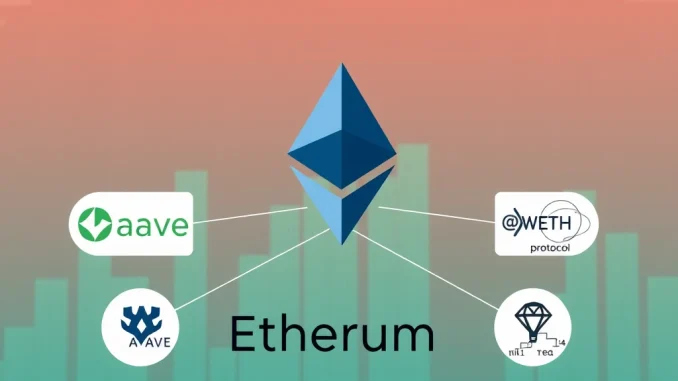
Hey crypto enthusiasts! Big news from the core of the ecosystem: the Ethereum Foundation has made a notable move in the world of decentralized finance (DeFi). According to blockchain sleuths like PeckShieldAlert, the Foundation recently took out a significant loan on the Aave protocol.
Ethereum Foundation Takes Out Aave Loan
The headline grabber is the Aave loan itself. The Ethereum Foundation borrowed 2 million units of GHO, Aave’s native decentralized stablecoin. This isn’t the first time the Foundation has interacted with DeFi protocols, but a loan of this size certainly attracts attention.
Borrowing stablecoins in DeFi allows entities to gain liquidity without selling their underlying volatile assets. It’s a common strategy used by individuals and institutions alike in the crypto space.
WETH Collateral Powers the Borrowing
To secure the $2 million GHO stablecoin loan, the Ethereum Foundation utilized a substantial amount of Wrapped Ether (WETH). Specifically, 10,000 WETH was provided as collateral on Aave back in February. At current market prices, 10,000 WETH represents a significant value, providing a healthy buffer for the loan against potential price drops.
Using WETH collateral is standard practice on lending platforms like Aave. WETH is simply Ether (ETH) tokenized to be compatible with the ERC-20 standard, making it usable across various DeFi protocols.
Here’s a quick look at the core components involved:
- Borrower: Ethereum Foundation
- Platform: Aave (Decentralized Lending Protocol)
- Asset Borrowed: 2 million GHO
- Collateral Used: 10,000 WETH
- Collateral Provided: February (on Aave)
Railgun Protocol Staking Also Noted
Adding another layer to the Foundation’s recent on-chain activity, the report also highlighted a stake in the privacy-focused Railgun protocol. The Foundation staked 50,000 RAIL tokens, valued at approximately $50,000 at the time of the report.
While smaller in value compared to the Aave transaction, the stake in Railgun protocol is interesting as it signals potential interest or support for privacy-enhancing technologies within the ecosystem. Railgun aims to provide private transactions for DeFi users.
Why Would the Ethereum Foundation Borrow GHO?
This is the big question many are asking. Why would the Ethereum Foundation, sitting on substantial ETH reserves, take out a stablecoin loan? Several potential reasons exist:
- Operational Flexibility: Accessing stablecoin liquidity can be crucial for covering operational expenses, funding grants, or making investments without needing to sell ETH holdings, which could have tax implications or market impact.
- DeFi Exploration: The Foundation may be actively exploring and utilizing DeFi protocols like Aave to better understand their mechanics, risks, and potential benefits firsthand. This could inform future ecosystem development or recommendations.
- Yield Opportunities: While not explicitly stated, borrowed stablecoins could potentially be used in other DeFi protocols for yield farming or liquidity provision, though this carries additional risk.
- Supporting GHO and Aave: By using Aave and borrowing GHO, the Foundation indirectly supports these key DeFi protocols built on Ethereum, showcasing their utility and stability.
Using WETH collateral allows the Foundation to retain exposure to the potential upside of Ether’s price while gaining access to stable funds needed for various purposes.
Understanding the Risks and Benefits
Taking out a collateralized loan in DeFi isn’t without its risks. The primary risk is liquidation. If the price of WETH were to fall significantly, lowering the value of the WETH collateral below a certain threshold relative to the borrowed GHO amount, the collateral could be automatically sold by the protocol to repay the loan. The Foundation would lose its WETH in this scenario.
However, the benefits are clear: access to non-volatile capital (GHO) without selling a core asset (ETH/WETH). This strategy is capital-efficient and allows the Foundation to maintain its long-term position in Ether.
What Does This Mean for the Ecosystem?
The Ethereum Foundation engaging directly with protocols like Aave and Railgun is a strong signal. It demonstrates confidence in the maturity and reliability of these DeFi platforms. It also highlights the practical use cases of decentralized lending and privacy tools for even the most foundational entities in the space.
The use of GHO stablecoin in this transaction also provides a boost to Aave’s decentralized stablecoin, increasing its usage and visibility.
In Summary
The Ethereum Foundation’s decision to borrow $2 million in GHO stablecoin on Aave, backed by 10,000 WETH collateral, is a notable strategic financial maneuver. It showcases the Foundation’s active engagement with the DeFi ecosystem and its potential use of decentralized protocols for liquidity management. Coupled with the smaller stake in the Railgun protocol, these actions provide a glimpse into how the Foundation is navigating and utilizing the very technologies it helps support and develop.



